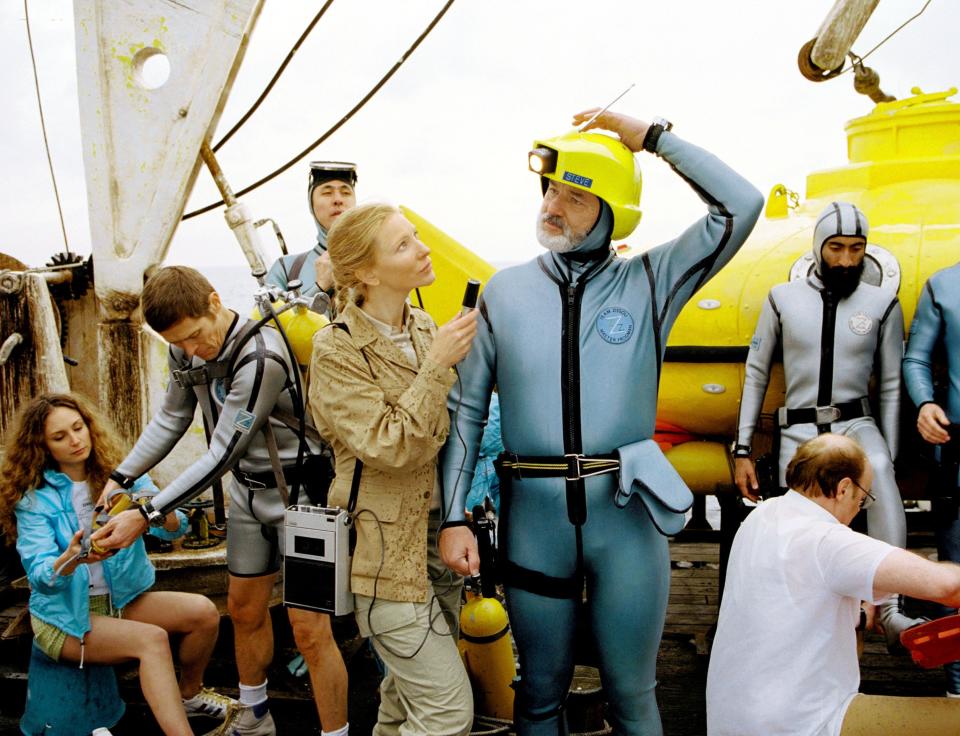Best of the Wes: How Anderson's collaborators make his films go
- Oops!Something went wrong.Please try again later.
- Oops!Something went wrong.Please try again later.
Wes Anderson’s “Asteroid City,” opening this week at Ragtag Cinema, promises a scope and a cast unlike what the filmmaker has traditionally delivered.
All the while, Anderson sticks close to themes, patterns, and the mise en scene that have changed little in the 27 years since becoming a staple of the American arthouse movie scene. Yet even under the auteur theory, filmmakers thrive and die by their collaborators. The release of "Asteroid City" gives us a chance to look at the most impactful partnerships of Anderson’s storied career and figure out which ones matter most.
Looming largest is Owen Wilson, who not only has acted in the majority of Anderson’s films, but co-wrote the first three — and arguably best — efforts: “Bottle Rocket,” “Rushmore” and “The Royal Tenenbaums.” Wilson and Anderson were roommates at the University of Texas in Austin and shot a short film that eventually became the basis for “Bottle Rocket” after none other than James L. Brooks picked up on their talents.
Wilson, in particular, felt like the biggest revelation in that debut film. With a buzzcut and a hair trigger temper, he came across as a funnier, hipper Dennis Hopper.
More than that, those earlier films lack a pretension that now feels like a trademark of Anderson’s work. When Wilson moved on to focus on his acting career, scribes like Noah Baumbach and Roman Coppola filled in. They seemed more like Anderson fanboys than true partners, indulging the biggest talent in the room. Wilson served as a check on Anderson’s worst impulses.
While even a lackluster Anderson film is more interesting than any average movie, they’ve never been quite as good without Wilson’s screenwriting contributions. If you’ve not seen “Bottle Rocket,” I urge you to do so. Anderson is unlikely to make as good a film as his first.
1998’s “Rushmore” also proved fortuitous in introducing Anderson to two men who became indispensable: Bill Murray and Jason Schwartzman. Murray brought not only weathered humor to miserable businessman Herman Blume, but also a melancholic sadness.
Murray’s performance elevated the film and also cemented the wisecracking superstar’s transition into a serious actor who became an angel to indie filmmakers over the past 25 years. Even when he’s playing bit parts like in “The Darjeeling Limited,” Murray brings gravitas to Anderson’s superfluousness.
Schwartzman, on the other hand, feels like a cipher for Anderson. If “Rushmore” was anything, it was a calling card for Anderson’s annoying but compelling brand of inventiveness. Max Fischer was an untethered talent whose skill was undeniable, if not a little grating. Sounds like Anderson acknowledging the best and worst of himself even at an early age in his career.
The two are kindred spirits. At a Q & A this past weekend, Schwartzman revealed he truly bonded with Anderson over Weezer’s “Pinkerton” album. That’s something any Gen X guy can appreciate.
Anderson’s style settled a bit after “The Royal Tenenbaums.” It was a film told as a novel with a beautiful production design that didn’t quite look normal. One feels the conflicts Anderson had with Gene Hackman, playing the patriarch of the titular family, made the director more resolute. All accounts were that Hackman, who retired not too long after, mocked and belittled Anderson in front of the cast and crew. One wonders if Anderson felt he had something to prove after suffering from the barbs of a towering, crusty movie star.

In 2004, Anderson added stop-motion animation to his “Life Aquatic with Steve Zissou” thanks to a collaboration with the renowned Henry Selick. The two planned to work together on “Fantastic Mr. Fox,” but Selick left to work on “Coraline.” Selick’s influence can be felt with “Fox” as well as “Isle of Dogs.” In fact, animation feels more akin to Anderson’s approach than live-action. Selick had a big hand in that, it seems.
Others actors became regulars of Anderson’s troupe: Ed Norton, Jeff Goldblum, Willem Dafoe, Adrian Brody and Tilda Swinton have made multiple appearances in his more recent work. A critique is that Anderson doesn’t make room for many women or minorities in his rotation. Certainly many directors are guilty of this.
Clearly, Anderson can attract talent and cultivates good relationships with exceptional actors. This is particularly impressive given he seems more interested in the look of his films rather than the characters.
Or perhaps it is the sense of technical wonder and experimentation — the elaborate sets, the use of animation, the costumes — that attracts talent to Anderson. The desert of “Asteroid City” certainly does look like a fun sandbox to play in.
James Owen is the Tribune’s film columnist. In real life, he is a lawyer and executive director of energy policy group Renew Missouri. A graduate of Drury University and the University of Kansas, he created Filmsnobs.com, where he co-hosts a podcast. He enjoyed an extended stint as an on-air film critic for KY3, the NBC affiliate in Springfield, and now regularly guests on Columbia radio station KFRU.
This article originally appeared on Columbia Daily Tribune: Best of the Wes: How Anderson's collaborators make his films go

